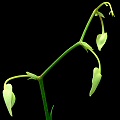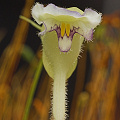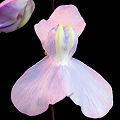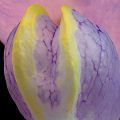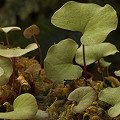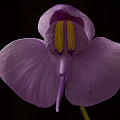Q: About epiphytic & emergent Utricularia
A: There is a group of Utricularia species which have a kind
of appeal that transcends that of the others. These are given such evocative names as the tuberous bladderworts,
orchid-flowering bladderworts, or ephiphytic bladderworts. They are stunning species.
OK, I admit that I am a little nutty when it comes to all Utricularia. The plants
are tiny, and the flowers are diminutive at best. Yet I really like them. I love few things more than laying down in a mucky
fen so I can get a closer look at a nice little affixed aquatic "utric." I am used to the fact that I am in the
minority---few people think these plants are worth notice. But when you see the flowers of the epiphytic species, no
qualifications are needed. They are simply glorious. You can see why people want to grow them so badly.
Epiphytic species are apparently restricted to Central and South America. They have found a niche for survival by growing
on improbable surfaces like the surfaces of trees (hence the name, epiphytic). However, some also grow in small clumps of moss
or even in terrestrial settings--they are still referred to as epiphytic species, albeit incorrectly.
Another group of species, often discussed with the epiphytic species, are ones that I refer to (somewhat unsatisfyingly) as
emergent species. I use this to describe species which are predominately aquatic species, and which have many bladderous
stolons in the water, but which have (often enormous) leaves which extend out of the water. Some of these emergent species
live in peculiar places, like the water-filled urns and axils of carnivorous bromeliads! These emergent species often have
flowers as spectacular as those of the epiphytic species.
Ephiphytic species can be very difficult to grow. They like quite different media from the
other species. Knowledge of how to grow epiphytic orchids may be relevant.
I will not say too much about growing them because I only have moderate experience with them.
I have successfully grown U. alpina, U. asplundii,
U. jamesoniana, a purported U. alpina × endresii hybrid, and
also the lovely hybrid Utricularia 'Jitka.'
These all seem to respond well to a lighter mix than the fiducial pure Sphagnum. I am fond of a
Sphagnum: perlite mix, however those using live Sphagnum do well, too.
If you use live Sphagnum make sure you use a species that does not overgrow the
Utricularia. Keep the plant a little drier than you are used to with carnivorous plants. Always water
from above---setting the plant in a tray of water seems to be harmful.
I had a breakthrough in growing U. jamesoniana when I first took it out of the tray it was sitting in, and hung it in
the greenhouse in a little plastic orchid basket. Within a few months, it was flowering from the sides and bottom of the pot--hardly any growth is
emerging from the soil on the top of the pot.
Many of these grow in cool cloud forests or comparable conditions, so do not cook them. I suggest temperatures in the range
16-27°C (60-80°F), just like for Heliamphora. Do not fertilize them. But listen up---I do not
consider myself the most skilled of growers for these plants, so consider the recommendations of those who might have differing
prescriptions. Those who have read my book can review my Golden Rules of cultivation!
The emergent species are also tricky to grow, but they want very different conditions. The best thing for these should be, I think,
either a very wet and coarse mix of live Sphagnum. You could also try forcing a bit of air into the
mix by adding large-grain perlite or light pumice. A Sphagnum slurry
(with either live or dead Sphagnum) might work well. From this group I have grown
U. humboldtii, U. reniformis, and U. nelumbifolia
(but not very successfully).
Use the same temperatures I suggest for the epiphytic species, never fertilize, and good luck!
Page citations: D'Amato, P. 1998; Rice, B. 2006a;
Taylor, P. 1989; personal observations.
